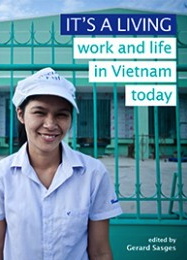Gerard Sasges, editor, It’s a Living: Work and Life in Vietnam Today. With photographs by Mai Huyền Chi, and a foreword by Andrew X. Pham.
Singapore: NUS Press, 2013. Pp. xxiii, 313; colour photographs
Reviewed by Annuska Derks.
…at the end of the day, even though farming is a really low-paid job, we have to love our work: we don’t have a choice. Vietnamese farmers just have to love their work; I mean really, what other jobs are out there? (page 18)
In the first chapter of It’s a Living: Work and Life in Vietnam, a farmer describes how she followed the path of her parents, how she combines different agricultural and non-agricultural activities to make a living and how farming work has changed over time. While her story as such is not unique, her descriptions of the past, her imaginings of the future and her feelings towards her work make it a distinctively personal account. And this is exactly what makes It’s a Living: Work and Life in Vietnam such an engaging read. It is the kind of book that I would have loved to have read when I came to Vietnam four years ago.
It’s a Living: Work and Life in Vietnam describes how Vietnamese make a living, or “look for food” –kiếm ăn in Vietnamese. It is a testimony to the major changes that have taken place in the world of work in Vietnam since the beginning of market-oriented reforms, under the policy of đổi mới, in 1986. Seventy percent of the country’s rural population is still working in agriculture. Yet, as Vietnam’s economy is rapidly modernizing, people are increasingly moving out of agricultural work, and also out of their villages, in order to take up industrial, service and sales jobs. More than half of Vietnam’s workforce is now working outside agriculture.(1) So the question, one asked by the farmer quoted above herself, is, what are these other jobs out there? To get an idea, one just has to read the volume’s other 66 interviews, in which Vietnamese of different ages and from different socio-economic backgrounds describe their daily work and their lives, worries and aspirations as they “look for food” for themselves and their families.
It’s a Living is the product of a course that its editor, Gerard Sasges, taught in the University of California’s Education Abroad Program in Vietnam, which included both foreign and Vietnamese students. Inspired by the 2000 book GIG: Americans Talk About their Jobs at the Turn of the Millennium (2), students set out to interview Vietnamese about their work. This focus on work reflects the idea that work offers an important window into people’s lives, as it is what most of them do during the greater part of their waking hours, and that all types of jobs are worthy of respect, interest and time (page xv). Sasges’s students thus collected the stories of Vietnamese working in an incredibly wide variety of professions inside and outside of Vietnam, from a respectable but bored bank employee to a bookie looking for an easy life, from an undistinguished garment-factory worker to a famous artist, from a nurse who had delivered more than 2000 babies to a mama-san managing over 100 sex workers.
All together, these stories shed light not only on “the energy and struggle” (back flap) that characterize the world of work in contemporary Vietnam but also on how people’s lives and work are intimately tied to the historical events and contemporary developments briefly described in the volume’s introduction. Vietnam’s history of war marked the course of life and work of the veteran who fought the Khmer Rouge in Cambodia as well as that of the erstwhile “boat people” struggling to make a living in the United States. The stories in It’s a Living also vividly illustrate social and economic changes in contemporary Vietnam, as we encounter many people who have moved to the city to work, as the large differences in incomes reported reflect rising inequality, as women interviewed engage in a range of jobs that are not only in the informal sector or home-based, and as religious freedom has opened up for some (re-)new(ed) paths for earning an income or serving people. Despite such obvious changes, the stories demonstrate the continued importance of the family, which on the one hand provides support for learning skills or finding a job and on the other hand needs support. This latter need is often the prime motivator to endure long separations and sometimes hard, dirty, dangerous or tedious work.
Yet what I found most compelling is that the stories are not just about hardship, but that they convey the pride and joys of work. Through their work people feel connected, as in the case of the security guard; they build self-confidence, as in the case of the promotion girl; they bring pleasure to the lives of others, as in the case of the flower seller; they live out their passions, as in the case of the electrical appliance repairman; they meet their spouses, as in the case of the garment-factory worker; and, above all, they secure the necessary means to make a living and to allow their children to go to school and to aspire for a better future. These prides and joys, these very personal feelings and aspirations expressed in lively language, often get lost in more academic studies on labour in Southeast Asia. Instead of researchers speaking about the life and work of Vietnamese, this book lets the people speak for themselves.
This strength may, however, also be seen as the book’s weakness. As can be expected, not all interviewees were equally open. All their stories are therefore not equally successful in bringing out the couleur locale of their work and life. Moreover, by merely presenting edited versions of the interviews, the volume offers accounts that lack the kind of thick description that would bring in-depth understanding of the social networks, the capital, the skills and wit that shape the world of work in Vietnam. But this is also not what the book aims to do. Rather, It’s a Living: Work and Life in Vietnam provides the reader with rare glimpses of the realities of working and living, and through those glimpses an unpretentious but succinct account of how ordinary people live with the incredible economic, social and cultural changes that characterize early twenty-first-century Vietnam.
Annuska Derks is a visiting lecturer at the University of Social Sciences and Humanities – Vietnam National University, Hanoi.
References
1. The World Bank. Vietnam Development Report 2014 – Skilling Up Vietnam: Preparing the Workforce for a Modern Market Economy. Washington: International Bank for Reconstruction and Development, 2013 (http://www-wds.worldbank.org/external/default/WDSContentServer/WDSP/IB/2013/11/26/000461832_20131126115640/Rendered/PDF/829400AR0P13040Box0379879B00PUBLIC0.pdf, accessed 2 February 2014), page 10.
2. Bowe, John, ed. GIG : Americans Talk About Their Jobs at the Turn of the Millennium. New York : Crown Publishers, 2000.
 Facebook
Facebook  Twitter
Twitter  Soundcloud
Soundcloud  Youtube
Youtube  Rss
Rss 
